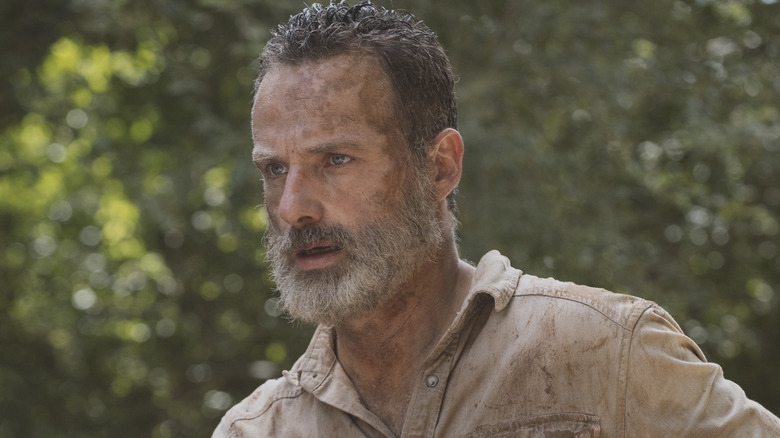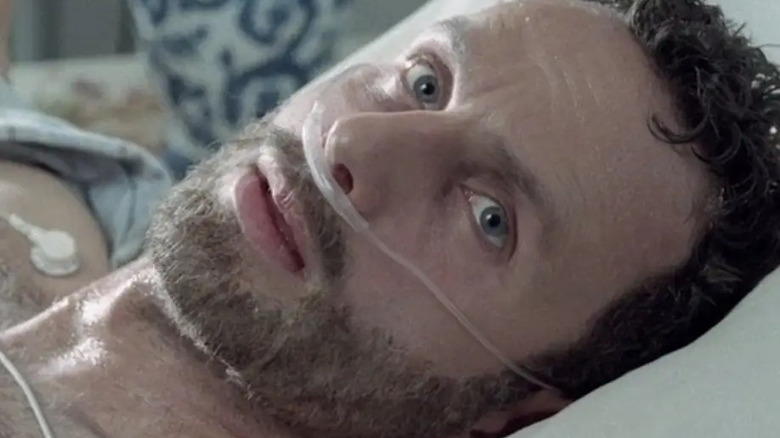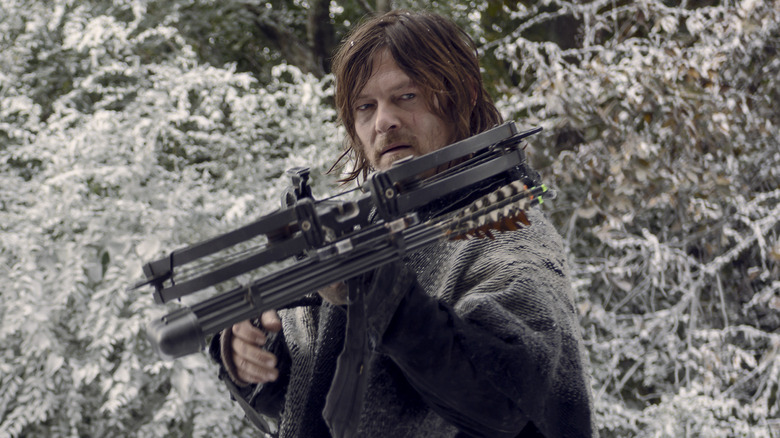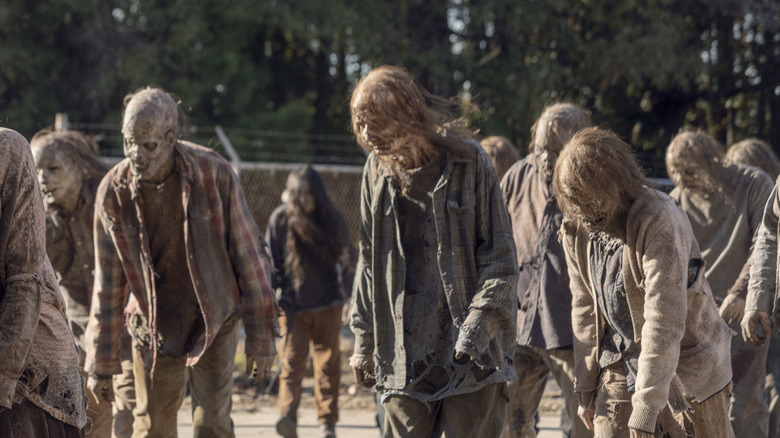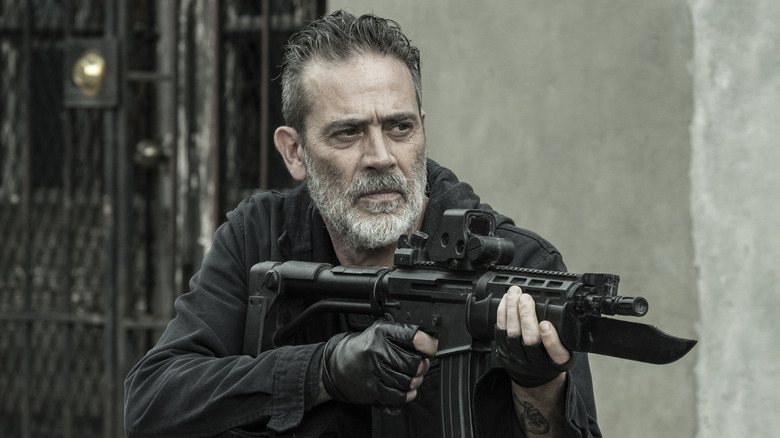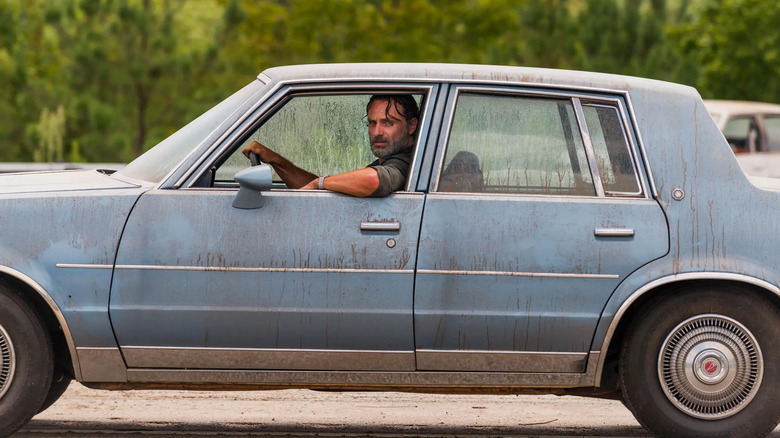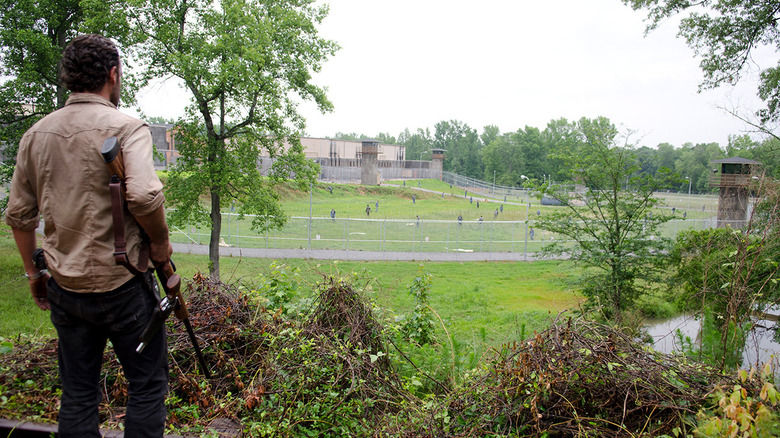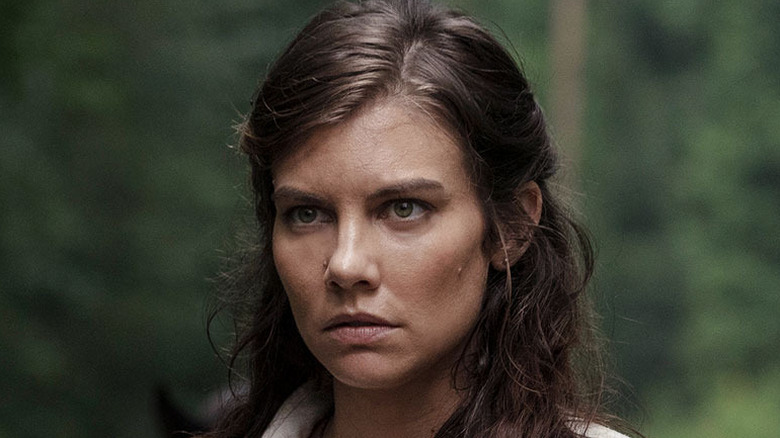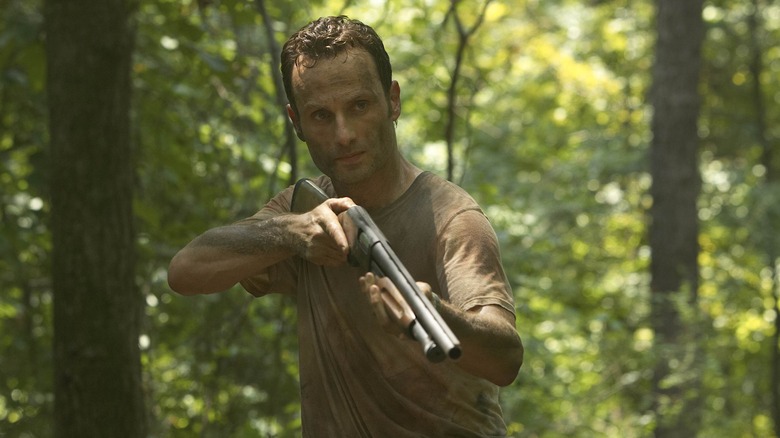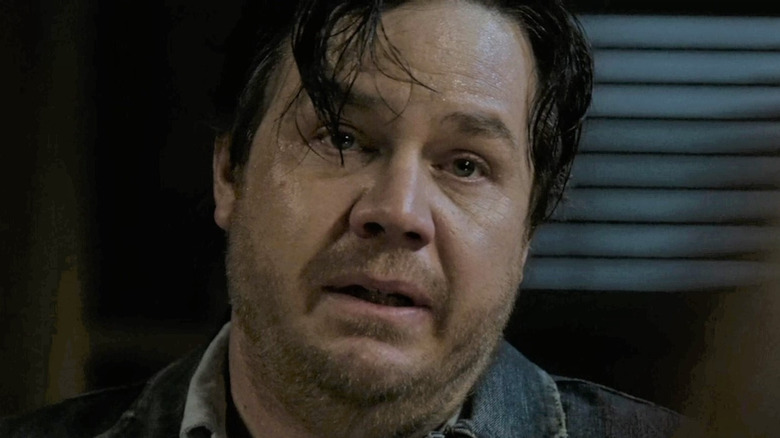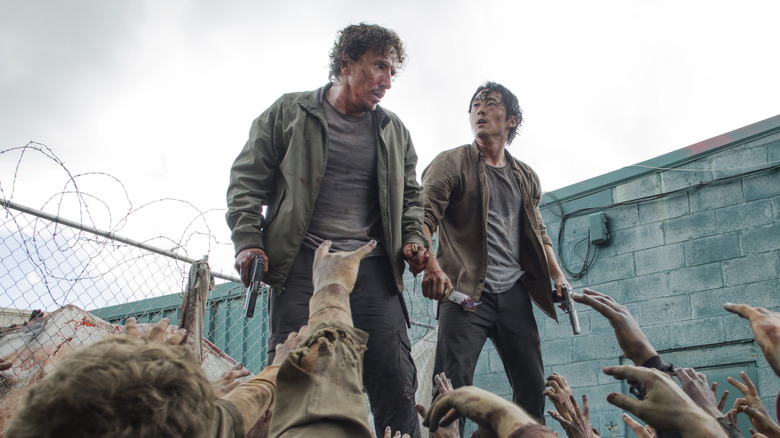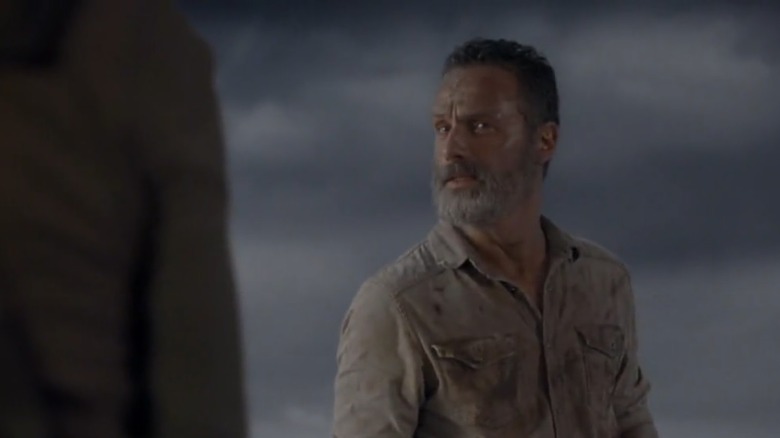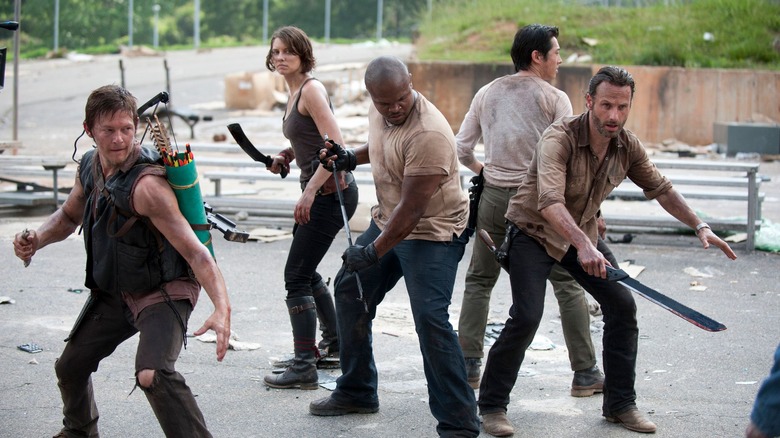Things That Never Made Sense About The Walking Dead
It's safe to say that anyone who watches TV has heard of "The Walking Dead." Based on the comic book series of the same name, the show aired on AMC in 2010 and had the most successful cable series premiere of all time at the time. Millions of people tuned in to watch the characters fight zombies while trying to survive in a post-apocalyptic world. It was gritty and terrifying, but beyond all the gory fight scenes, the show really had a heart.
After 11 seasons, the final episode aired in 2022, but that doesn't mean the franchise is dead. There are many spin-off series, including "Fear the Walking Dead" and "The Walking Dead: Dead City."
Although "The Walking Dead" is extremely popular, there are still some things that have never made sense about the series. From the characters surviving fatal wounds to the zombies having inconsistent strength and speed, there are many aspects of the show that simply can't be explained. Let's explore some of the biggest inconsistencies and plot holes below.
Rick survived a gunshot wound and coma with little to no medical care
In the very first episode, Rick Grimes (Andrew Lincoln) awakes from a coma and finds himself in the middle of a zombie apocalypse. While this certainly makes for a dramatic backstory, it's never made clear how Rick managed to survive up until that point. Prior to the apocalypse, Rick was a sheriff's deputy and sustained a gunshot wound while trying to stop some criminals, putting him in a coma for quite some time.
Dave Erickson, showrunner and executive producer of the spin-off series, "Fear the Walking Dead," told Business Insider more about the length of Rick's coma during an interview in 2015. He explained that Robert Kirkman, co-creator of the comic and executive producer of the show, said that "Rick was probably out four to five weeks."
That's a lot of time to be in a coma without medical attention. However, in the web series, "The Oath," we learn there was a doctor who stayed at the hospital after the outbreak and continued taking care of patients for a while. This helps explain how Rick survived his coma, but he still wakes up alone and malnourished. That would imply he hasn't had medical care in a while, so the exact timeline of events doesn't really make sense.
Most of the episodes took place in Georgia, but it hardly ever snowed
Rick and the rest of the survivors stay in Georgia for most of the series. Georgia has hot and humid summers, but it gets very cold and starts snowing during winter. Despite this, we hardly ever see the survivors deal with snow in "The Walking Dead." This is very odd considering that over a decade passed since the initial outbreak and the final season of the show.
In fact, there isn't a single snowflake until the Season 9 finale. Showrunner Angela Kang told CinemaBlend in 2022, "One of the things we were trying to do this season is play with the rhythm of the storytelling a little bit, and hopefully do some things that we hadn't done before."
Between fending off walkers and battling dangerous groups of people, the characters already have a lot to deal with, but seeing them brave the elements upped the ante even more. Since snowfall only adds to the drama, it's interesting that so little of the show takes place during wintertime. Even taking the six-year time jump between Seasons 8 and 9 into consideration, our heroes should've encountered snow at least five times throughout the series.
No one used the word zombie
"The Walking Dead" is undoubtedly a show about zombies, but the characters never use that word. They usually describe the undead as walkers, although they also call them biters, rotters, empties, roamers, lurkers, and skin eaters. So, why exactly did the characters never utter the Z-word? During an interview with Conan O'Brien in 2016, Kirkman said, "We wanted to avoid that notion of, 'Hey, why doesn't that character just shoot that zombie in the head because it saw all those movies I saw?' We wanted to kind of give you a sense that 'The Walking Dead' takes place in a universe where zombie fiction doesn't exist."
Artifacts have suggested that several ancient civilizations told zombie stories, some dating as far back as the 17th century. Zombie stories are intricately linked with human history, so it seems unlikely that none of the characters would've ever heard of the concept before. Unlike the TV show, characters in the comics did use the Z-word sometimes.
"I think Glenn says it a couple times, but those were mostly slip-ups," Kirkman said (via Fansided). "Then I came up with the 'lurkers' and 'roamers' terminology. After a while though, it felt silly to just keep using those over and over. So by the time I got into the teens and twenties on the book I thought, 'Screw it, they're zombies, I'm just going to have people call them zombies. Who cares.'"
It's unclear whether or not zombie blood could infect people
In Season 8, Negan (Jeffrey Dean Morgan) devises a plan for his group to smear zombie guts on their weapons, infecting anyone unlucky enough to be attacked by them. It sounds like a pretty good plan — except that it reveals a huge plot hole about whether or not zombie blood can infect people.
If survivors get infected every time zombie DNA enters their bloodstream, there are several instances in which characters should've gotten infected, but somehow don't. In Season 2, Episode 10 ("18 Miles Out"), Shane gets trapped in a school bus while fighting against walkers. He then uses a dirty knife to cut his hand, using his blood to distract them. In Season 7, Episode 10 ("New Best Friends"), Rick goes up against a zombie with spikes coming out of its body. His leg gets cut by one of the blades, which we can assume is covered in infected blood since it is impaling the zombie's body.
If survivors can't get infected by exposure to zombie blood, Negan's plan would make absolutely no sense. On top of that, it begs the question of why the survivors wouldn't have smeared zombie guts on themselves more often to avoid danger. They use this tactic to safely camouflage themselves in Seasons 1 and 5 — and of course, there are the Whisperers, who regularly wear zombie faces to blend in with herds of the undead.
The survivors were able to drive around
From the group's invincible Hyundai Tucson to Daryl's (Norman Reedus) iconic motorcycle, the survivors have used many different vehicles throughout the show. The problem is that the story takes place over a number of years, and gasoline has an expiration date, so the survivors shouldn't have been able to use vehicles for most of the show.
RAC Limited, a British automotive services company, confirmed this information in 2019: "Generally speaking, petrol has a shelf-life of six months if stored in a sealed container at 20 degrees [Celsius] — or just three months if kept at 30 degrees." It expires even more quickly when stored in an open container. "Once you've put fuel in a jerry can or other containers, you only have a few months before the quality starts to fall away — even less if the fuel is contaminated in any way."
They go on to explain that using old gasoline can damage vehicles and impact their overall performance. However, this isn't the only reason why characters shouldn't be able to drive in the show. Think about how much maintenance vehicles require on a regular basis. Flat tires, dead batteries, and transmission problems are pretty common problems to deal with. When you consider that most of the vehicles in the show have been sitting unattended for months or years on end, and not every group has a mechanic, seeing the survivors cruising around just doesn't add up.
Some lawns appeared to be freshly mowed
Survivors in a post-apocalyptic world would have way more to worry about than landscaping, so why are there freshly mowed lawns in the show? The prison that Rick and the gang discover in Season 3 has a large, well-maintained yard, despite no one taking care of it. There are some prisoners there when the group arrives, but they have been locked in the cafeteria for months, so they wouldn't have had access to the lawn.
Was there a zombie landscaper that still had the basic motor skills to push a lawnmower across the field? Before the show aired, AMC released some rules that all zombies in the show follow, which included this one: "Zombies are not dexterous. They cannot pick up or use any items more complex than a rock or a stick." Using a lawnmower is much more complex than picking up a rock, so it seems like a walker wouldn't have been able to cut the grass after all.
During an interview with Chris Hardwick in 2017, showrunner Scott M. Gimple finally addressed this enigma: "I am working on a story. All of these years, why the grass is cut will be answered. I don't know what medium, might be fan fiction, but it will be told."
The survivors stayed well-groomed
It seems like it'd be hard to carve out "me time" in the middle of a zombie apocalypse, yet the survivors seem to have no problem with it. In between making supply runs and fighting for their lives, they manage to maintain stylish haircuts, like Carol (Melissa McBride) rocking a short pixie cut and Negan having shaved sides of his head.
For the most part, the men do a great job grooming their facial hair, whether they are sporting a majestic beard or just the right amount of stubble. But let's not forget that the ladies of the show stay especially well-groomed. In addition to keeping their eyebrows on point at all times, they make sure to prioritize shaving, so there aren't any hairy legs or armpits in sight. Their smooth, radiant skin hints at a 10-step nightly routine and an effortless "no makeup" makeup look.
No matter how dire the situation gets, all of the survivors have stylish clothes that fit them perfectly. Yes, they are a bit dirty and have some holes in them, but that kind of wear and tear could happen over the course of a week-long camping trip. And can we talk about how great everyone's teeth look? Even without regularly seeing dentists, they still have beautiful, straight, white teeth. We can see how they could spend time maintaining their appearances while staying at Alexandria, but it's not that realistic throughout the rest of the series.
There were hardly any zombie children
There are many different types of walkers in the show, from those that couldn't move around, to those that wandered back home, and everything in between. Despite all the zombie variants, zombie children seem to have been left out of the series for the most part.
Ironically, the first zombie that ever appears on the show is a little girl. In the very first episode, Rick tries talking to her, but then she starts getting aggressive and he has to shoot her. After that, there are a handful of other zombie kids, such as Carol's daughter Sophia, the Governor's daughter Penny, and Noah's unnamed brother.
However, that's nothing compared to the countless hordes of adult zombies that threaten the survivors at every turn. The scarcity of zombie children is unusual, especially considering that in the universe of "The Walking Dead," everyone has the virus and turns into a zombie after they die, whether or not they are bitten.
Characters never lost weight despite enduring harsh conditions
The survivors face all kinds of danger throughout the series, including the possibility of starvation. At the beginning of Season 3, the group has been on the run for a while and Carl (Chandler Riggs) is so hungry that he almost resorts to eating canned dog food. There have even been episodes when the group has to walk miles on end, like when they are trying to find Terminus in Season 4, but all that extra cardio doesn't lead to any weight loss.
When it comes to body weight, viewers have had questions about two characters in particular: Tara (Alanna Masterson) and Eugene (Josh McDermitt). In a 2016 Instagram post, Masterson fired back at body shamers and explained that she'd just had a baby before filming Season 7. McDermitt addressed his own character's appearance during an interview with Entertainment Weekly in 2018: "I wanted to lose weight. I lost a little bit of weight, but ... it's hard to go from one week to the next and you go, 'Well, it would be awesome if I was 30 pounds lighter' ... but that's physically impossible."
No one is saying that actors should be body shamed or pressured to lose weight. However, when the story of the show involves extremely meager rations and grueling journeys on foot, a little makeup or CGI to temporarily slim down the characters would make things much more realistic.
The zombies decomposed in unrealistic ways
Viewers suspend their disbelief of zombies existing for the sake of the show, but "The Walking Dead" universe is still based in reality, so many other aspects are supposed to be the same as they are in real life. That makes it hard to ignore the unrealistic ways that zombies decompose in the show.
During a 2015 interview with MTV News, forensic archaeologist Kimberlee Moran said all the zombies' eyes would be gone in about nine months if they were decaying at a normal rate. The bodies would also become bloated, causing their skin to detach and slip off, and they would all be reduced to skeletons within one to three years. Moran added that bodies become fully rigid three to six hours after death due to rigor mortis, so zombies wouldn't be able to move at all until a few days after this effect wore off.
Before the show aired, AMC released a rule about zombies that stated, "Zombies decay but at a much slower rate than humans." This partially explains the walkers' questionable decay rate, but it still seems like they should have been more decomposed in the later seasons. According to CinemaBlend, Kirkman said, "The natural progression is that, yeah, eventually there will be very, very few zombies in this world because most of them will have died off and decayed away ... Will the series last long enough for us to get there? Only time will tell!"
Rick miraculously survived an explosion
Is Rick immortal? It certainly seems that way since he's able to survive the bleakest of situations, like the bridge incident in Season 9, Episode 5 ("What Comes After"). He is bleeding heavily after being thrown off his horse and impaled by a rebar in the previous episode. Fading in and out of consciousness, he leads a huge herd of walkers to a bridge and set off an explosion to protect the rest of the survivors.
He is on the bridge with the herd when this happens, so his friends and family assume he tragically died in the explosion. We later learn that Rick somehow survived the blast, fell into the zombie-infested river below, and washed up on shore without drowning, getting bitten, or losing a critical amount of blood. We get that the writers didn't want to kill Rick off since he's the main character, but it's ridiculous how many injuries this man can recover from. Any side character would've died as soon as they fell onto the rebar, or at the very latest, during the explosion.
The zombies had inconsistent strength, speed, and intelligence
Most of the walkers in the show are weak, slow, unintelligent, and uncoordinated, especially compared to the zombies in other franchises like "28 Days Later." Despite this, there are many instances when the zombies act completely differently than usual. Some of them are strong enough to single-handedly crack glass, break through walls, or drag a grown man away.
When it comes to speed, AMC's set of rules for the show state that zombies can't sprint; the fastest they can move is a "shambling run." In addition, they explain that the "ability to run is based on the amount of time a zombie has been undead, and how much decay has set in." However, there have been times when walkers are able to keep pace with characters running at full speed. One glaring example of this is in the Season 2 premiere ("What Lies Ahead") when Sophia (Madison Lintz) is running for her life and two walkers are able to keep up with her just fine.
And what about the zombies' varying levels of intelligence and dexterity? In the show's first episode, a zombie returns home and tries to open the door. In the next episode, a zombie chasing after Rick and Glenn (Steven Yeun) has the wherewithal to climb over a chain link fence without breaking its legs. These instances seem like a far cry from the walkers mindlessly stumbling around all day.
